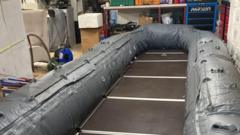
A new study from Hong Kong reports that some of the microbes found in a range of urban environments ...
[+] are evolving to resist the cleaners we typically use to eliminate them. New research shows that city microbes have adapted to survive on disinfectants Even on our loneliest day, no person is ever truly alone, because our bodies harbor trillions of microbes ; everything from single-cell organisms called archaea, to fungi, bacteria and viruses. Together, they inhabit just about every surface on – and crevasse within – us, outnumbering our own cells 10 to 1 .
While it might sound a bit icky to be immersed in a microbial ‘soup’, it is not generally harmful to us. And in fact, it provides functions that are vital to our health, like supporting our immune response and our digestive system . Each human microbiome is entirely unique, influenced slightly by our genetics, but mostly by our surroundings .
Just like humans, every city on Earth has its own microbiome; its community of microbes shaped by residents and visitors of all species, and the lives they lead within the built environment. Geography, weather and climate, construction materials, infrastructure design and ventilation are just a few of the factors that influence the urban microbial landscape. The location too, plays a role – the diversity of microbes present will differ greatly between the soil of an urban park, a wastewater pipe, or a covered concrete parking garage.
But no matter where you go in a city, you’ll interact with organisms too small to see. Scientists have been studying urban microbiomes with increasing interest for decades. As more of the Earth’s human population moves into cities, understanding the relationships we have – be they harmful, benign, or beneficial – with these communities of microorganisms will become ever more important.
A global research consortium called MetaSUB (The International Metagenomics and Metadesign of Subways and Urban Biomes) is leading the charge in this effort. Launched in 2015 to address the knowledge gap in urban microbial ecosystems, members now take part in a synchronized sampling event on 21 st June each year. During this ‘Global City Sampling Day’, researchers collect samples of DNA, RNA and microbes from surfaces in subways, buses, airports, and other public spaces, in cities scattered around the world.
In 2021, MetaSUB published what they describe as “ the first extensive global metagenomic study of urban microbiomes .” It involved researchers in 60 cities, who together collected and processed 4,728 samples from at least three common surfaces (railings, benches, and ticket kiosks) in their local mass transit systems; these locations were used as a proxy for the city microbiome as a whole. The study revealed a “core” urban microbiome across all cities, with the same 31 microbes present – in varying amounts – in more than 97% of samples.
However, they also found “distinct geographic variation” between cities, as well as “regional signatures”, suggesting that each city’s microbiome is unique. UFC Cuts 8 Fighters, Including Top-10 Ranked Contender ‘Your Money Is Being Wasted’—Tesla Billionaire Elon Musk Declares ‘Financial Emergency’ As $35.7 Trillion ‘Debt Bomb’ Primes A Bitcoin Price Boom To Rival Gold Leak Reveals A $1.
4 Trillion China Earthquake Could Be About To Hit Crypto As The Bitcoin Price Soars Over $70,000 Many surfaces in transit systems are recolonized with microbes within minutes of cleaning Resistant to cleaning One member of the MetaSUB consortium is Dr Xinzhao Tong, an assistant professor at Xi'an Jiaotong-Liverpool University (XJTLU), China. In her latest study , she reports that some of the microbes found in urban environments are evolving to resist the cleaners we typically use to eliminate them. “I have been studying the microbiome of the built environment since my PhD,” she says, speaking to me over Zoom.
“I started out looking at the diversity of microbes present in different types of urban environments, like residences, malls, subways. But I found myself wondering how these microbes survive. Many of the areas we study are already low in traditional nutrients, and our use of cleaning products adds additional stress.
This sets the built environment apart from other microbe habitats.” To investigate how so many types of microorganisms have adapted to life in the concrete jungle, Tong and her team took 738 samples from a variety of locations across Hong Kong; one of the most densely-populated regions on the planet. The samples included subway air, commonly-touched surfaces in piers, private residences, subways, and public facilities, as well as from the skin surfaces of human participants.
They then used an advanced technique called shogun metagenomics to identify all of the genes (short DNA fragments) in all of the microorganisms present in each sample. By comparing these DNA fragments against a vast database of known genes, Tong could confirm which were known and which were novel. In addition, Tong says, “Because each gene encodes specific functions, the technique allows us to characterize the functions of these uncharacterized species, and understand a bit more about how they adapt to their surroundings.
” From this, the team identified 373 microbial strains that had never previously been reported in an urban environment. Two novel strains of a microbe called Patescibacteria were recovered from skin samples. This microbe is considered ‘parasitic’ as it typically relies on bacterial hosts to supply its nutrients.
But these novel strains seem to have the ability to make two antioxidants – carotenoids and ubiquinone – that we humans need to survive. “We typically acquire them, especially carotenoids, through our diets,” says Tong. This suggests “a possible mutualistic relationship between bacteria and us as their hosts.
" The most surprising finding was a novel strain of Eremiobacterota on skin samples and from one private residence. This microbe is more often associated with the harsh, acidic environmental conditions of the Antarctic soil. It first gained attention in 2021 when it was found to be able to ‘fix’ carbon by oxidizing trace gases from the atmosphere, and using them as a source of energy.
The Eremiobacterota strain found in the city samples had genes capable of using a different fuel source, as Tong explains, “We noticed that this microbe seems to be able to metabolize some of the traditional ingredients of disinfectants that are widely used in cleaning. Things like alcohols some inorganic salts. We know we want to create a clean built environment, especially after the COVID pandemic, but I feel like the microbes are very intelligent.
They try to evolve to resist against our cleaning strategy.” Hospital-acquired infection rates remain high in this post-COVID pandemic era (Photo by Christopher ..
. [+] Furlong/Getty Images) Clinical environments Tong was quick to reassure me that none of the microbes identified in her study were found to be pathogenic – i.e.
capable of causing human diseases. She also explained that shogun metagenomics does not distinguish between living microbes and dead ones, “it is difficult to confirm the viability of the microbe from the results. But if a microbe has the genes, we can say it has the potential to survive and adapt to the built environment, outcompeting other strains.
” While Tong’s research, and that of others, suggests that cities contain high number of antimicrobial resistant genes , and many surfaces in transit systems are recolonized with microbes within minutes of cleaning , that does not necessarily mean that cities are more microbially ‘dangerous’ to healthy individuals than other areas. However, as she sees it, there are risks to immunocompromised people that should not be ignored, “There’s a phenomenon we call cross-resistance that means if this microbe is resistant to disinfectants, it may also develop resistance to antibiotics. And if this microbe is capable of affecting humans, then that resistance is a problem, especially for those with compromised immune systems.
” If that’s you, she says “it would be a good idea to protect yourself by wearing a mask, especially in busy indoor areas, because pathogens are opportunists.” In clinical conditions such as hospitals, these opportunist pathogens can be life-threatening. The rates of hospital-acquired infections associated with antimicrobial resistance increased significantly during the COVID pandemic, and they’re still elevated today .
This prompted Tong and her colleagues to start a new research project, focused on hospital surfaces frequently touched by healthcare workers. Her analysis is still ongoing, and the research is yet to be published, but she says they have found some genes that show resistance to disinfectants and heavy metals (factors that have been linked to antibiotic resistance ). “Even though we spend so much effort to clean hospitals, we cannot seem to eradicate all pathogens.
My hypothesis is some microbes have adapted to the hospital's environment, and the pressures we pose to clean or to kill those pathogens may actually be promoting their resistant development. We must do something about the disinfectant strategies hospitals apply, or we’ll just keep isolating the resistant microbes.”.













